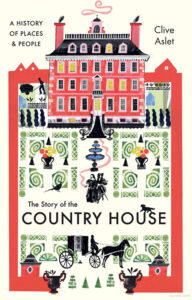Book Review: The Story of the Country House
by Jessie Dean
From its charming cover alone, this recent publication from Yale University Press caught our eye, but when multiple members recommended it, we knew The Story of the Country House: A History of Places & People by Clive Aslet was worthy of your attention. Aslet begins with the deceptively simple question of how we can define and contextualize a British country house as a place of retreat and enjoyment:
My definition of the country house is this: a work of domestic architecture in a rural location, surrounded by its own land (although not necessarily a landed estate) and intended to seem a self-contained unit: its own ‘little kingdom’…The inhabitants value it for many things: love of the land, status, self-expression through architecture and, not least, the pleasure to be had there, with gardens, horses, dogs, art, [and] collecting.
With a conversational approach, Aslet eagerly brings us along as he sorts more than 800 years of country houses by time period, style, and purpose. Each is complicated by the multiple and unavoidable iterations of any house that survives for generations, reflecting the changing circumstances and taste of each owner (for example, see pp. 8-10). Elegantly capturing the fluidity of labeling country houses, Aslet writes that even those that “strongly evoke a single period are often palimpsests where one era overwrites another, a process that may happen again and again until the deep past is no more than a ghostly, indecipherable smudge.”
Although Aslet acknowledges that luxurious country houses were by nature the domain of the wealthy, he does strive to recognize those who toiled onsite to ensure their effective and efficient operation. Noting this history is “not for the faint-hearted,” sustaining a country house required those who labored in the mines, mills, and plantations that supplied the resources that funded the construction and upkeep of these grandiose structures and estates.
As we prepare for our Study Trip Abroad to East Anglia next spring, the frequent notes on sites in that region are a welcome introduction, including an extended description of Holkham Hall, a remarkable Palladian pile on northern Norfolk’s coast completed in 1765. The initial construction lasted more than 30 years, outlasting both William Kent, who designed the house, and the 1st Earl of Leicester, for whom it was built. Aslet introduces dozens of notable country houses with anecdotes for context, and I only wish there were pictures accompanying every captivating piece of architecture described.
Each chapter covers a broad time period that allows a single approachable book to cover the centuries between Medieval architecture and present-day preservation efforts. Whether you want to digest the full survey of country house history or pick and choose the chapters covering your favorite styles, The Story of the Country House is an excellent and compact introduction, and gratefully includes extensive notes for further reading to assist the reader who wishes to dive deeper.
Jessie Dean is the Membership Coordinator at the Decorative Arts Trust.
A print version of this article was published in The Magazine of the Decorative Arts Trust, one of our most popular member benefits. Join today!


